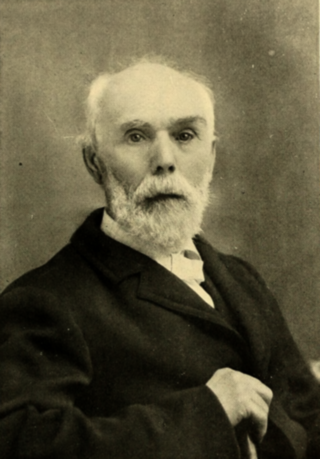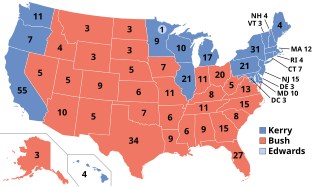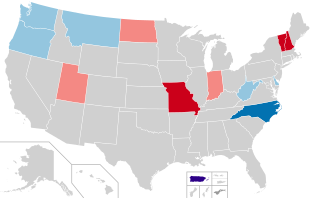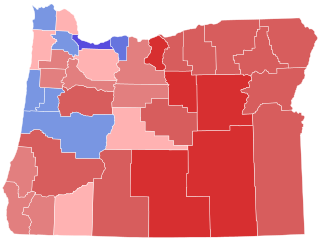
There have been 91 gubernatorial elections in the state of New York since 1777, with the most recent being held on November 8, 2022. The next election is scheduled to be held on November 3, 2026.

The 1966 United States Senate elections were elections on November 8, 1966, for the United States Senate which occurred midway through the second term of President Lyndon B. Johnson. The 33 seats of Class 2 were contested in regular elections. Special elections were also held to fill vacancies. With divisions in the Democratic base over the Vietnam War, and with the traditional mid-term advantage of the party not holding the presidency, the Republicans took three Democratic seats, thereby breaking Democrats' 2/3rds supermajority. Despite Republican gains, the balance remained overwhelmingly in favor of the Democrats, who retained a 64–36 majority. Democrats were further reduced to 63–37, following the death of Robert F. Kennedy in June 1968.

The 2006 Oregon gubernatorial election took place on November 7, 2006. Incumbent Democratic Governor of Oregon Ted Kulongoski ran for a second and final term as governor. Kulongoski faced several challengers in his primary, whom he dispatched to win his party's nomination a second time, while Republican nominee Ron Saxton, the former Chair of the Portland Public Schools Board and a candidate for governor in 2002 emerged from a crowded primary. Kulongoski and Saxton were initially going to be challenged in the general election by State Senator Ben Westlund, but Westlund withdrew his candidacy before the general election. There were multiple independent and third party challengers on the ballot as well. In a hard-fought campaign, Kulongoski won re-election by a surprisingly wide margin, winning his second term as governor.

John Whiteaker was an American politician, soldier, and judge. A native of Indiana, he joined the army during the Mexican–American War and then prospected during the California Gold Rush. After moving to the Oregon Territory, he served as a judge and member of the legislature. A Democrat, Whiteaker served as the first state Governor of Oregon from 1859 until 1862 and later was Oregon's Congressman from 1879 to 1881. He also was president of the Oregon State Senate and Speaker of the Oregon House of Representatives.

United States gubernatorial elections were held on November 5, 2002, in 36 states and two territories. The Republicans won eight seats previously held by the Democrats, as well as the seat previously held by Minnesota governor Jesse Ventura, who was elected on the Reform Party ticket but had since renounced his party affiliation. The Democrats won 10 seats previously held by the Republicans, as well as the seat previously held by Maine governor Angus King, an independent. The elections were held concurrently with the other United States elections of 2002.

The 2004 United States elections were held on Tuesday, November 2, 2004, during the early years of the war on terror and after the 2003 invasion of Iraq. Republican President George W. Bush won re-election and Republicans retained control of Congress.

The 2010 United States elections were held on Tuesday, November 2, 2010, in the middle of Democratic President Barack Obama's first term. Republicans ended unified Democratic control of Congress and the presidency by winning a majority in the House of Representatives and gained seats in the Senate despite Democrats holding Senate control.

The 2010 Oregon gubernatorial election was held on Tuesday, November 2, 2010 to elect the Governor of Oregon to a four-year term beginning on January 10, 2011. The incumbent governor, Democrat Ted Kulongoski, was ineligible to run due to term limits barring him from being elected to more than two consecutive terms.

The 1998 Oregon gubernatorial election took place on November 3, 1998. Democratic nominee John Kitzhaber easily defeated Republican Bill Sizemore to win a second term. Kitzhaber won 35 out of 36 counties, the only county won by Sizemore was Malheur County. This is the only gubernatorial election since 1982 in Oregon in which the margin of victory was in double digits. It is also the most recent election in which any county in Eastern Oregon or Southern Oregon voted for the Democratic nominee, and the most recent gubernatorial election in which a candidate would win while carrying the majority of the state's counties. Sizemore would run again for governor in the 2022 election, but would lose in the Republican primary.

The 1930 Oregon gubernatorial election took place on November 4, 1930 to elect the governor of the U.S. state of Oregon. The Oregon Republican Party, at the time dominant in Oregon politics, initially nominated George W. Joseph, but the nominee died prior to the general election. Joseph's former law partner Julius Meier entered the race as an independent, and defeated replacement Republican nominee Phil Metschan, Jr., Democrat Edward F. Bailey, and Socialist Albert Streiff to become the first and only Independent politician to be elected Governor of Oregon.

The 2014 Oregon gubernatorial election was held on November 4, 2014, to elect the Governor of Oregon, concurrently with other elections in Oregon and across the United States.

United States gubernatorial elections were held on November 8, 2016, in 12 states and two territories. The last regular gubernatorial elections for nine of the 12 states took place in 2012. The last gubernatorial elections for New Hampshire, Oregon, and Vermont took place in 2014, as Oregon held a special election due to the resignation of Governor John Kitzhaber, while the governors of New Hampshire and Vermont both serve two-year terms. The 2016 gubernatorial elections took place concurrently with several other federal, state, and local elections, including the presidential election, Senate, and House elections.

The 2016 Oregon gubernatorial special election took place on November 8, 2016, to elect the Governor of Oregon, concurrently with the 2016 U.S. presidential election, as well as elections for the U.S. Senate and U.S. House of Representatives, other gubernatorial elections and various state and local elections.

The 1902 Oregon gubernatorial election took place on June 2, 1902 to elect the governor of the U.S. state of Oregon. The election matched Republican W. J. Furnish against Democrat George Earle Chamberlain.

The 2018 Oregon gubernatorial election was held on November 6, 2018, to elect the governor of Oregon to serve a full four-year term. In the 2016 special election, Democratic governor Kate Brown had been elected to serve the last two years of John Kitzhaber's term.

United States gubernatorial elections were held on November 8, 2022, in 36 states and three territories. As most governors serve four-year terms, the last regular gubernatorial elections for all but two of the seats took place in 2018. The gubernatorial elections took place concurrently with several other federal, state, and local elections, as part of the 2022 midterm elections.

The 2022 Oregon gubernatorial election took place on November 8, 2022, to elect the governor of Oregon. Incumbent Kate Brown took office when fellow Democrat John Kitzhaber resigned on February 18, 2015. She won the subsequent 2016 special election a full term in 2018. Due to term limits, she was unable to run again in 2022.

The 1862 Connecticut gubernatorial election was held on April 7, 1862. It was a rematch of the 1861 Connecticut gubernatorial election. Incumbent governor and Republican nominee William Alfred Buckingham defeated Democratic nominee James Chaffee Loomis with 56.48% of the vote.

The 1860 Massachusetts gubernatorial election was held on November 6. Incumbent Republican governor Nathaniel Banks did not run for re-election to a fourth term. He was succeeded by Republican John Albion Andrew, a radical abolitionist.





















